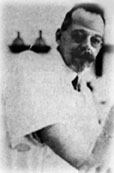 Virology
Class Syllabus
Virology
Class Syllabus
Felix D'Herelle 1917
Evaluations will be based on class attendance and participation (including bringing in extra relevant material), making mini-presentations throughout the quarter, a quarter-end major small-group presentation (3 people, 45 minutes) and your self evaluation. You will be expected to maintain a Portfolio of your work and turn it in at Week 5 and again at the end of the quarter, with your draft self evaluation.
I have intentionally left this initial syllabus rather sketchy, and will give you a more detailed one once I have a chance to better see your interests and needs.
Book List (* denote required):
Janeway - ImmunoBiology 5th edition -- Garland *
Biology of Microorganisms 9th or 10th edition -- Brock (a very good, broad microbiology text which some of you already have)
Principles of Molecular Virology 3rd edition -- Cann
The Biology of Viruses 2nd edition -- Voyles
| Week | Class | Reading |
| Week 4 Oct. 23rd |
DUE: several page write-up summarizing your first 3 weeks - what resources have you used, what did you find most interesting (in some detail), what was most challenging for you; how have you divided your time? Guest: Raul Raya - bacteriophage as vectors for gram-positive bacteria; probiotic lactic acid bacteria Seminar: groups of 6-8: book related to AIDS - followed by whole-group discussion
|
HIV and AIDS - an overview: Janeway 450-64; 632-3, + Brock 904-11 |
|
Week 5 Oct. 30th |
Short immunology quiz, corrected in class The horrible H's: the Herpes viruses and the Hepatitis viruses - examples of various viral life styles and challenges. |
Readings in your virus references and Brock Also, handouts from Encyclopedia of Virology and from "Pathogenesis in Diagrams" |
| Week 6 Nov. 6th |
DUE: 2 nd several page write-up summarizing your 1st 5 weeks - what resources have you used, what did you find most interesting (in some detail), what was most challenging for you; how have you divided your time? Guest: Heather Zwickey hzwickey@ncnm.edu - new NCNM research director; immunologist Vaccines: challenges, benefits and nightmares (handouts; Janeway 577-592) |
|
| Week 7 Nov. 13th | 1) Guest: Cheri Lucas-Jennings - Evergreen MES program - Guillain-Barre syndrome 2) Seminar - integrate ideas from 2 sets (1½hours)
of herpes, hepatitis, and aids biology readings - write your findings
& questions afterwards & email to me - list your group members |
|
| Week 8 Nov. 20th | 1) Back to basics: infection biology, [review t-phage handout & herpes] & basics ideas of replication, transcription, translation, 2) Viruses, oncogenes & cancer 3) Betty's Cold Spring Harbor Meeting report! |
Handouts: Neural and Immunological Synaptic Relations Immune escape through C-type lectins on dendritic cells From these readings, write a careful summary of what you understand, with enough detail to catch your occasional areas of confusion, and formulate well thought out questions as sophisticatedly as possible of the information that you don't understand, distinguishing carefully between the two. Email Betty or bring this to the next class. |
| No Class Nov. 27th |
|
|
|
Week 9 Dec. 4th |
Student Presentations: HPV, Viral Oncogenes, Cholera, Small Pox | |
| Week 10 Dec. 11th | Student Presentations: West Nile, Prions, Baculoviruses, Cucumber MV |  |
|
Evaluation Week Dec. 18th |
||
GUEST SPEAKERS:
Robin Moore, Olympia's first naturopathic physician
Cheri Lucas-Jennings, a personal account of Guillan-Barre'
syndrome
Burton S. Guttman, Lysogeny and Lambda
Raul Raya, as vectors for gram-positive bacteria; probiotic lactic acid bacteria
RESOURCES:
I have not found an appropriate single text for
this program, so we will use a combination of suggested readings in:
short readings handed out, readings and books on reserve, and your own explorations of the literature.
Good other resource books include:
G. L. Smith, W. L. Irving et al: New Challenges
to Health: The Threat of Virus Infection (2001)
SJ Flint et al- Principles of Virology: molecular
biology, pathogenesis and control (2000)
I have the older edition of Webster - Encyclopedia
of Virology and the library is ordering the most recent division.
Immunology studies will be woven throughout the quarter. While we will only be studying certain aspects of immunology - primarily those most relevant to viral infection, + psychoneuroimmunology - a number of you may want to get an immunology book, both for use here and for future reference. They are available at Amazon.com for around $60. (There will be some immunology books on the reserve shelf as well.) Possible choices include:
Roitt and Rabson - Really essential Medical
Immunology - 2000
Kuby's Immunology - 4th edition - Goldsby et
al. - 2000 WH Freeman
Janeway - ImmunoBiology 5th edition -- Garland
PRESENTATIONS:
Students will be required to give substantial
presentations at the end of the quarter, preferably in groups of about 3, and
will also be very much encouraged to give short individual presentations throughout
the quarter as part of the general class sessions.
Questions to address in general in presentations:
virus family, basic properties and infection cycle. modes of transmission, reservoirs,
breadth of infectivity, ecological factors and effects; vaccine availability
and effectiveness, nature and length of immunity induced by natural infection
and from various available vaccine types;
Some suggested topics for student presentations:
Adenoviruses and gene therapy
Baculoviruses (plant viruses) and molecular biology
Cholera, filamentous and temperate phages, and pathogenicity islands
The Hantavirus epidemic: tracking down the etiology; social concerns
Morbilliviruses, world-wide agriculture and endangered species
Common family members: measles (MV), canine distemper virus (CDV - ferrets, mink, panda, seals), rinderpest ((RPV - ruminants - buffalo, kudu, eland); phocid distemper virus (PDV - seals); cetacean morbillivirus (CeMV - whales, porpoises, dolphins)
Mouse Mammary Tumor Virus (MMTV), mtv and the roles of superantigens
Prions
Rabies (a negative-strand RNA virus)
Rotavirus (a reovirus) and infant diarrhea in 3rd-world countries
Smallpox: infection process and consequences, vaccination, eradication and potential for bioterrorism